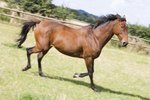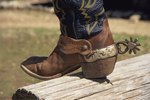
Correct posture when you’re riding your horse western style is more than just about how you look; unless you’re being judged in a riding competition, how you look only matters because proper posture allows your horse to move freely and reduces your potential for joint and body pain. As a rider, you establish a physical connection with your horse so that every body movement affects his. In this way, your posture affects his posture. A relaxed and proper posture allows you to move freely with your horse, not against him. (Ref 3, 4).
Overall Body Alignment
Practice how your body should line up when riding both on and off a horse. An observer should be able to draw an imaginary line from your ear to shoulder, down to your hip and carrying downward to your heel. Achieve this by allowing your legs to hang straight down from your hips while you’re straddling your horse, or a fence rail for practice. Look straight ahead and don't slouch. Then imagine that someone pulls the rail out from under you -- you should land solidly on your feet with little to no adjustment necessary.
Back and Stomach
When riding, how you position your back affects your stomach and vice versa.. Some riders want to arch their backs, which can cause soreness either during or after riding. It also naturally causes you to shift your weight forward with your stomach in front of your seat, and to raise and tighten your hands. Odessa Johnson, a horse trainer and owner of Crimson Jewel Stables in New Braunfels, Texas, suggests that you squeeze your shoulder blades together to help you get your shoulders back in a natural position. “This gives the rider a very straight but relaxed posture,” says Johnson. “At the same time, focus on keeping your stomach muscles over your seat and not in front of it.”
Arms and Hands
Your horse is sensitive to how you hold the reins. Think of the reins and bridle as a telegraph machine you use to communicate to him with your arms and hands. You transmit relaxation or tension to his mouth and it affects his entire body. A relaxed posture helps you keep your arms and hands relaxed; let them hang freely down at your sides and then pick your rein hand and gently hold the reins between your fingers. Your free hand should rest gently on your thigh or across your stomach. Remember that your horse’s head follows your hands, so if you raise your hand, he’ll raise his head and lose his relaxed posture, as well.
Legs and Feet
In Western riding, you want your legs to be long. Your legs should hang freely down with knees slightly bent so that your calves maintain light contact with your horse’s sides without pinching your knees. Do not thrust your legs forward; they should hang at the girth to stay aligned with your ears, shoulders and hips. To gauge if you’ve adjusted your stirrup length correctly, stand up in them with your heels slightly down and knees slightly bent. In this position, there should be about 3 inches between your hind end and the saddle. Put just the balls of your feet in your stirrups and don’t point your feet outward; you don’t walk that way, so don’t ride that way. Allow your feet and ankles to follow the natural angle of the stirrup so you are relaxed from tip to toe for optimum posture.
References
Resources
Photo Credits
-
Photodisc/Photodisc/Getty Images
Writer Bio
Based in Central Texas, Karen S. Johnson is a marketing professional with more than 30 years' experience and specializes in business and equestrian topics. Her articles have appeared in several trade and business publications such as the Houston Chronicle. Johnson also co-authored a series of communications publications for the U.S. Agency for International Development. She holds a Bachelor of Science in speech from UT-Austin.



